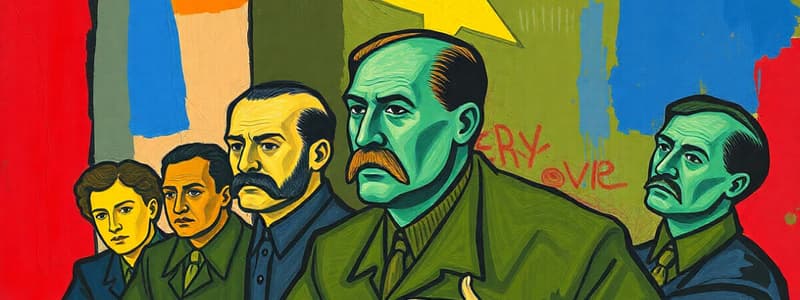Podcast
Questions and Answers
What was a primary goal of the Bolsheviks regarding education?
What was a primary goal of the Bolsheviks regarding education?
- To promote religious education
- To focus solely on elite education
- To eliminate illiteracy and make education accessible (correct)
- To maintain the existing education system
What type of education was emphasized to support industrialization during the early Soviet period?
What type of education was emphasized to support industrialization during the early Soviet period?
- Technical and vocational training (correct)
- Arts and humanities
- Classical literature
- Religious education
By the late 1930s, approximately what percentage was the literacy rate in the Soviet Union?
By the late 1930s, approximately what percentage was the literacy rate in the Soviet Union?
- 30%
- 80% (correct)
- 65%
- 50%
What was a key characteristic of the education system during the Stalinist era?
What was a key characteristic of the education system during the Stalinist era?
During the Stalinist era, there was a strong focus on what subjects?
During the Stalinist era, there was a strong focus on what subjects?
What type of education did Khrushchev introduce?
What type of education did Khrushchev introduce?
What was a significant aspect of higher education in the USSR by the 1970s?
What was a significant aspect of higher education in the USSR by the 1970s?
What subjects were mandatory in Soviet higher during the Brezhnev era?
What subjects were mandatory in Soviet higher during the Brezhnev era?
What happened to censorship during the Gorbachev era?
What happened to censorship during the Gorbachev era?
What was one of the effects of the economic crisis during the Gorbachev era on the education system?
What was one of the effects of the economic crisis during the Gorbachev era on the education system?
Flashcards
Education for All
Education for All
The Bolsheviks' goal to eradicate illiteracy and provide education freely to everyone.
Liquidation of Illiteracy
Liquidation of Illiteracy
Campaign launched in 1919 by the Bolsheviks to make all Soviet citizens between ages 8 and 50 literate.
Centralized Education System
Centralized Education System
Curricula introduced in 1934 with strict discipline and rote learning, emphasizing science and math to boost industrialization.
Polytechnic Education
Polytechnic Education
Signup and view all the flashcards
Political Indoctrination
Political Indoctrination
Signup and view all the flashcards
Glasnost Reforms
Glasnost Reforms
Signup and view all the flashcards
Perestroika Reforms
Perestroika Reforms
Signup and view all the flashcards
Study Notes
- Bolsheviks sought to eradicate illiteracy and provide accessible, free education to all.
- Mass literacy campaigns started in 1920, targeting both workers and peasants.
- Religious education was removed from curriculums and Marxist ideology became central.
- There was an increased emphasis on technical and vocational training to support industrialization.
- Literacy rates rose from approximately 30% in 1917 to over 80% by the late 1930s due to literacy campaigns.
- In 1919, a campaign was launched to make all Soviet citizens between the ages of 8 and 50 literate.
Stalinist Era
- In 1934, standardized curricula was introduced along with strict discipline and rote learning.
- There was an increased focus on science, mathematics, and engineering to support industrialization.
- Soviet history and Communist Party achievements were glorified.
- Russian language was promoted over regional languages.
- New universities and technical institutes were established.
- Women gained increased access to education, especially in STEM.
Khrushchev and Brezhnev Era
- Between 1958 and 1964, Khrushchev introduced polytechnic education, integrating practical job training.
- Schools were expected to prepare students for factory and farm work.
- Reforms were unpopular and later reversed under Brezhnev.
- By the 1970s, the USSR had a very high university enrollment rate.
- There was an emphasis on science, engineering, and military technology to compete with the West.
- Subjects like “Scientific Communism” and “Marxist-Leninist Philosophy” were mandatory.
- Pioneer and Komsomol organizations reinforced Communist values among youth.
Gorbachev Era
- Censorship was eased, allowing more critical discussion of Soviet history because of Glasnost and Perestroika reforms.
- Some schools experimented with less ideological teaching.
- Funding cuts led to deteriorating school conditions because of the economic crisis.
- Teacher wages stagnated, leading to lower morale.
- More control was given to local governments.
- By 1991, the rigid Soviet education system was beginning to break down.
Studying That Suits You
Use AI to generate personalized quizzes and flashcards to suit your learning preferences.




